“What’s in a name? That which we call a rose by any other name would smell as sweet.”
William Shakespeare, Romeo and Juliet, 9th grade English—somewhere in the neighborhood of 25 years ago…Even though it has been that long since I read Shakespeare’s famous play, every time that someone asks me “Anne, do you name your animals?” my mind immediately goes back to Juliet and her impassioned speech.
I suppose that this is what happens when your mother teaches high school English—Shakespeare becomes permanently imprinted on your brain!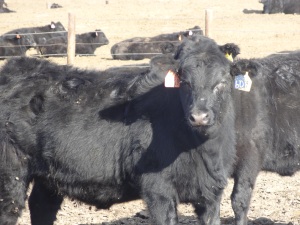
So, what is in a name—and, perhaps more importantly, how do I name my animals?
I had several readers last week ask me about animal identification. Most specifically, I was asked to explain the ear tags that my cattle wear. There were several pictures of ear tags in the video that I put up last week which sparked some great questions.
We use ear tags to identify our animals. We give them numbers instead of names. The lack of drama involved in giving a number to a calf would disappoint Mr. Shakespeare immensely; however, it is a very practical way for us to trace the performance of our animals. Many of my cattle are wearing three different ear tags.
The first is a tag that the calf is given at birth. This tag tells who the mother (cow) and father (bull) of the animal was, along with his birthdate. This information is important because it tells us the genetics of the calf. As we trace the calf from birth to harvest, we look at the efficiency of the animal’s growth performance (how easily does he grow and put on muscle), and also the quality of the beef that the animal produces at harvest time. Knowing the calf’s genetics allows us to select for bulls and cows that produce the most efficient and high quality animals. Identification through the use of an ear tag makes this logistically possible.
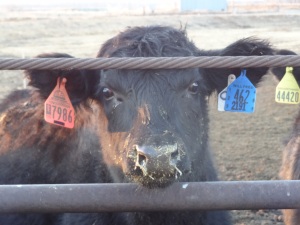
The orange tag is the PVP tag: it signifies age and source verification as well as a Veterinary Quality Assurance certification based on the Beef Quality Assurance program.
The second tag is a Process Verified Tag (PVP tag). It is a one-time use, tamper-resistant tag with a unique and non-repeatable number. This tag allows the animal to be eligible for specific niche markets (including foreign export), and verifies compliance with age and source documentation on the animal. For more information on PVP programs, you can go to http://processverified.usda.gov. All of the cattle that I currently have on my farm are USDA Age and Source Verified animals that are eligible for niche markets.
The third tag is a cowboy tag. This is a tag that we put in at the feed yard that helps my crew and I know which pen the animal belongs in. Each pen of animals has a unique cowboy tag with both a group number (which all of the animals in the pen share) and an individual number. The cowboy tag is very useful when checking health and making sure that each animal is in the correct pen. We have 24 different pens at the feed yard with almost 3000 animals in total on my farm—it is nice to have a cowboy tag to reference to make sure that all of the cattle are in the correct home pen.

You can see that the animals in this pen share a green cowboy tag. I love this picture because it also shows the calf in the middle who was so excited for breakfast that he started eating before the feed truck finished delivering his food. As a result, he is “wearing” some of his breakfast!
Fortunately, cattle have pretty large ears so there is enough room for them to wear three different tags at the same time. Having multiple tags also ensures that we never loose the identification of an animal. Sometimes an ear tag will fall out, but since all of my animals are wearing more than one tag and all of the tags are cross-referenced together, their identity is not lost. When my animals ship to harvest, it is mandatory that each one of them have a PVP tag. In fact, when they arrive at the packing plant, a USDA inspector is present to make sure that each one has their unique PVP identification so that they can remain eligible for niche markets.
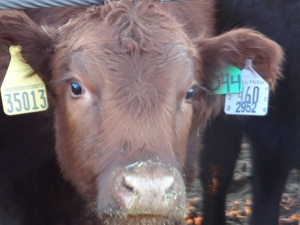
Some of our animals carry a yellow PVP tag instead of the orange one. The yellow tag also denotes eligibility for participation in the Age and Source PVP program.
The short answer to the question is that there is a lot in a name–especially if you are talking about the identity of a food animal! Animal identification is important for quality control, food safety, and the consistent measurement and improvement of animal performance.
Hopefully I was successful in answering your questions!

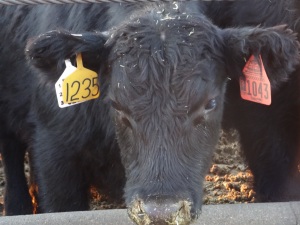
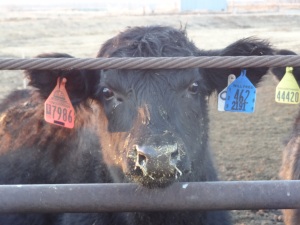
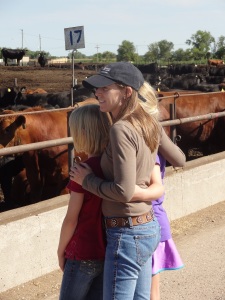

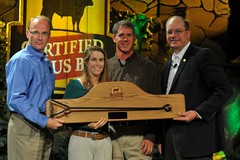
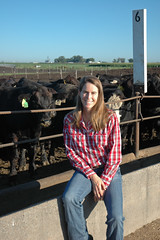






The most important technology in improving quality, quantity and relative cost of beef has been the tag and the ability to manage the records it makes possible.
I agree, Rex. It is an incredibly important management tool as we strive to improve animal care and food quality/safety while also working to reduce the environmental footprint of beef.
Thanks for sharing!
Anne
Are you guys looking at using the RFID tags like we have in Australia? I know there’s a lot of people using them here to do more than the mandatory tracking because you can scan each animal and track vaccines, growth rates etc electronically – much less paperwork!
Hi Rebecca,
We do use some RFID tags, although the majority of our cattle are tagged with the PVP visual orange or yellow dangle tag.
I use excel spreadsheets to track data electronically even with the dangle tags. The big plus of the dangle tag is that it makes another visual identification tag which you do not get with the RFID.
Both types of tags are good (in my opinion)–it will be interesting to see which way we trend toward over the next few years. At this point, most of my cow/calf ranchers prefer the dangle tags to the RFID because they do not have scanners.
Thanks for asking and commenting!
Anne
hey look at that Megan is cooking and wearing the matching sweatshirt I gave her.
She loves the sweatshirt, Tehya! I have to steal if from her just to get it washed 🙂
Thanks for posting about this Anne it is really helpful 🙂
No problem–it was a fun one to write! I enjoy answering questions—and it is nice to know what people are wondering about.
Take care,
Anne
We have a small dairy, and up until now we’ve named our cattle and forgone eartags. But that’s really only scalable up to a certain point, and after a while names lose some of their lustre and you’ve got to start keeping numerical track. I do think that names on the cattle do make it a bit easier for city people to relate to farmers, though.
Those are great points, Jonathan. I agree with you and appreciate you joining the conversation!
Thanks so much for reading and commenting. Happy Holidays to you and your family.
Anne
Pingback: Winter Chores… | Feed Yard Foodie